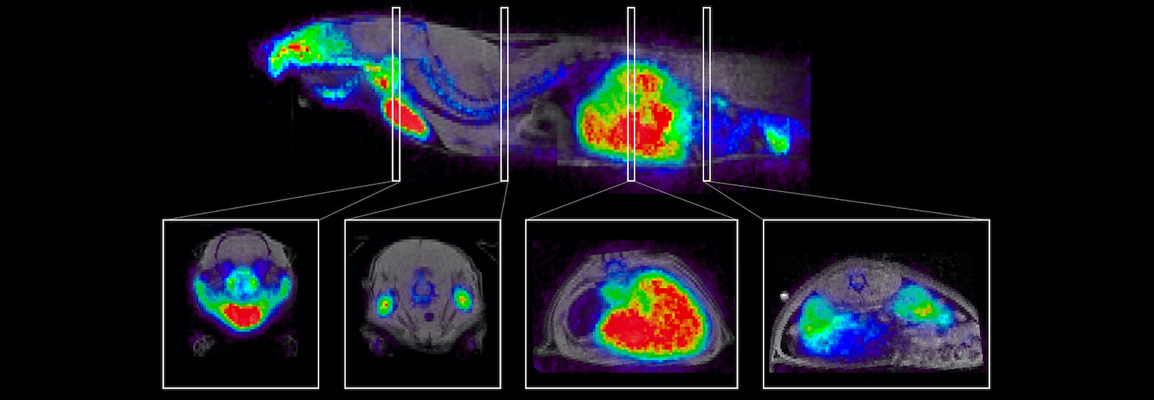

Hybrid PET/MR Enables Exploration of New Science Areas
Hybrid PET/MR Enables Exploration of New Science Areas
Positron emission tomography (PET) combined with magnetic resonance imaging (MRI) is a hybrid technology that brings together molecular sensitivity & specificity, morphologic and functional imaging to enable simultaneous, complimentary small animal imaging that does not alter the physiological state. This complimentary, simultaneous imaging opens new areas to explore across various fields including neuroscience, cancer, metabolic disease, and molecular probe development.
PET/MR combines the fields of nuclear medicine, molecular imaging and radiology to provide simultaneous, complementary small animal imaging that does not alter physiological parameters. In this webinar, preclinical molecular imaging experts Peter Caravan and Michael Heidenreich will discuss the synergies of this hybrid technology and the new avenues of exploration it opens up across areas ranging from neuroscience, cancer, and metabolic disease through to dual molecular probe development.
The implementation of state-of-the-art hybrid PET/MR technologies will be discussed with a focus on the PET Insert Si198 for mice and rats, applications using the Bruker BioSpec 47/40 PET/MR, and the introduction of the new PET Insert Si103 for mice and rat head applications using small bore Bruker MRI scanner
This webinar took place on June 25th, 2020
What to Expect
The benefits of combining the modalities for complementary imaging will be discussed, including a doubling of the information obtained and the unchanged physiological state once the two devices are used together rather than individually. Novel applications enabled by the hybrid technology in the field of preclinical imaging will be described and the first results of the new PET Insert Si 103 will be introduced.
Key Topics
- New applications enabled by PET/MR across areas including oncology, neuroscience, metabolic diseases, and molecular probe development
- Implementation of state-of-the-art hybrid PET/MR technologies
- First results and introduction timeline of the new “PET Insert Si 103”
Who Should Attend
This webinar will interest researchers in the fields of nuclear medicine, molecular imaging and radiology and would also appeal to anyone working in the field of biomedical imaging.
Speakers
Dr. Peter Caravan
Harvard University
Peter Caravan, PhD, is co-director of the Institute for Innovation in Imaging (I3)at Massachusetts General Hospital and an Associate Professor of Radiology atHarvard Medical School. He leads a multidisciplinary and translationalmolecular imaging lab (the Caravan Lab) focused on the invention of novel molecular probes andtheir broad applications in cardiovascular, pulmonary, renal and hepaticdiseases, as well as in cancers. His research spans novel chemistry technologies from advanced MRI and PET imaging in animal models to applicationsin patient populations. He holds Investigational New Drug (IND)applications for a fibrin-targeted PET tracer and a collagen-targeted PETtracer that are currently being evaluated in 6 clinical trials. He hasinvented molecular probes specific to fibrogenesis, acidosis, inflammationand thrombosis, as well as gadolinium-free MR contrast agents. Dr. Caravan received a PhD in Inorganic Chemistry from the University ofBritish Columbia. Following postdoctoral work at the EPFL (Switzerland), hespent 9 years at Epix Pharmaceuticals developing tissue-specific andresponsive MRI contrast agents, one of which, gadofosveset, was approved by theFDA and the EMA. He co-invented EP-2104R, which was the first molecularlytargeted MRI contrast agent to enter clinical trials. Since joining MGH in2007, he has been continuously funded by the NIH.
Dr. Michael Heidenreich
Bruker Vice President Nuclear Molecular Imaging
Michael received his PhD in C13 MRI imaging from the University of Ulm and joined Bruker in 1999 as an MRI application scientist. In 2005, he was appointed Productline Manager and has been responsible for Brukers BioSpec MRI imaging products for more than 10 years. Since 2016, he is managing the Nuclear Molecular Imaging Business Unit for PET/SPECT/CT and PET/MR imaging solutions with its main R&D and application teams in Valencia/Spain, Kontich/Belgium, Billerica/US and Ettlingen/Germany.